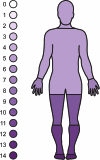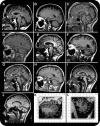Sensory neuropathy as part of the cerebellar ataxia neuropathy vestibular areflexia syndrome
- PMID: 21624989
- PMCID: PMC3115806
- DOI: 10.1212/WNL.0b013e31821d746e
Sensory neuropathy as part of the cerebellar ataxia neuropathy vestibular areflexia syndrome
Abstract
Objective: The syndrome of cerebellar ataxia with bilateral vestibulopathy was delineated in 2004. Sensory neuropathy was mentioned in 3 of the 4 patients described. We aimed to characterize and estimate the frequency of neuropathy in this condition, and determine its typical MRI features.
Methods: Retrospective review of 18 subjects (including 4 from the original description) who met the criteria for bilateral vestibulopathy with cerebellar ataxia.
Results: The reported age at onset range was 39-71 years, and symptom duration was 3-38 years. The syndrome was identified in one sibling pair, suggesting that this may be a late-onset recessive disorder, although the other 16 cases were apparently sporadic. All 18 had sensory neuropathy with absent sensory nerve action potentials, although this was not apparent clinically in 2, and the presence of neuropathy was not a selection criterion. In 5, the loss of pinprick sensation was virtually global, mimicking a neuronopathy. However, findings in the other 11 with clinically manifest neuropathy suggested a length-dependent neuropathy. MRI scans showed cerebellar atrophy in 16, involving anterior and dorsal vermis, and hemispheric crus I, while 2 were normal. The inferior vermis and brainstem were spared.
Conclusions: Sensory neuropathy is an integral component of this syndrome. It may result in severe sensory loss, which contributes significantly to the disability. The MRI changes are nonspecific, but, coupled with loss of sensory nerve action potentials, may aid diagnosis. We propose a new name for the condition: cerebellar ataxia with neuropathy and bilateral vestibular areflexia syndrome (CANVAS).
Figures


References
-
- Bronstein AM, Mossman S, Luxon LM. The neck-eye reflex in patients with reduced vestibular and optokinetic function. Brain 1991;114:1–11 - PubMed
-
- Rinne T, Bronstein AM, Rudge P, et al. Bilateral loss of vestibular function. Acta Otolaryngol 1995;(suppl 520):247–250 - PubMed
-
- Rinne T, Bronstein AM, Rudge P, et al. Bilateral loss of vestibular function: clinical findings in 53 patients. J Neurol 1998;245:314–321 - PubMed
-
- Migliaccio AA, Halmagyi GM, McGarvie LA, et al. Cerebellar ataxia with bilateral vestibulopathy: description of a syndrome and its characteristic clinical sign. Brain 2004;127:280–293 - PubMed
-
- Zingler VC, Cnyrim C, Jahn K, et al. Causative factors and epidemiology of bilateral vestibulopathy in 255 patients. Ann Neurol 2007;61:524–532 - PubMed
MeSH terms
LinkOut - more resources
Full Text Sources
Medical
Molecular Biology Databases
Miscellaneous
